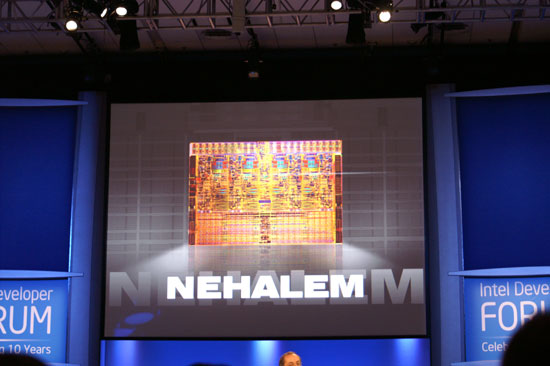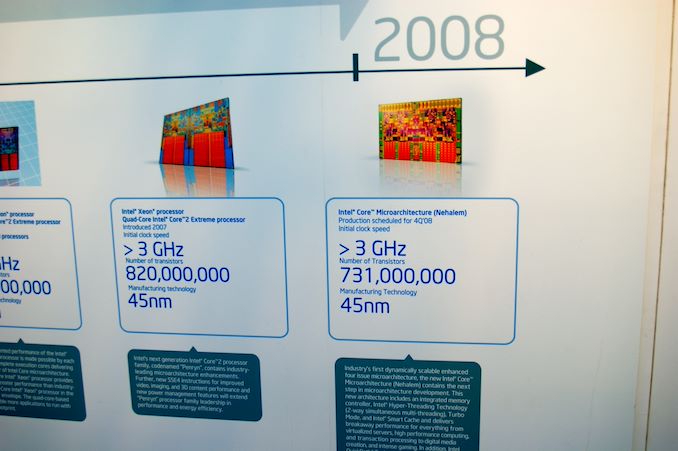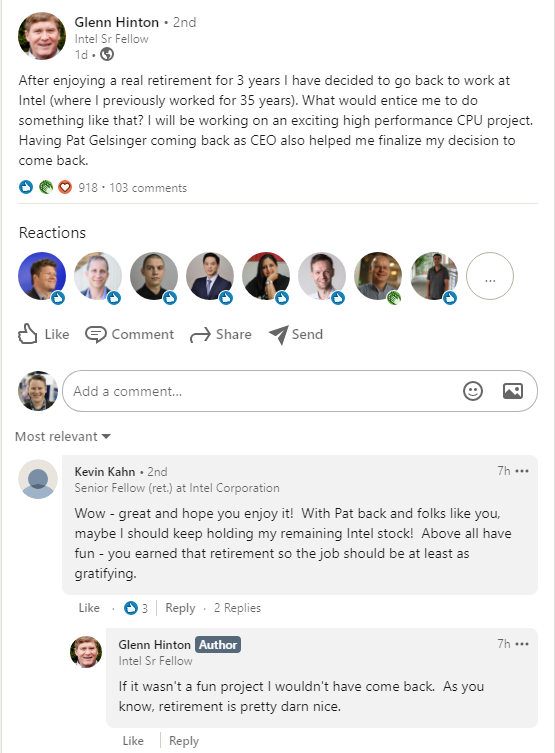New Intel CEO Making Waves: Rehiring Retired CPU Architects
by Dr. Ian Cutress on January 21, 2021 5:05 AM EST- Posted in
- CPUs
- Intel
- Nehalem
- Pat Gelsinger

We’re following the state of play with Intel’s new CEO, Pat Gelsinger, very closely. Even as an Intel employee for 30 years, rising to the rank of CTO, then taking 12 years away from the company, his arrival has been met with praise across the spectrum given his background and previous successes. He isn’t even set to take his new role until February 15th, however his return is already causing a stir with Intel’s current R&D teams.
News in the last 24 hours, based on public statements, states that former Intel Senior Fellow Glenn Hinton, who lists being the lead architect of Intel’s Nehalem CPU core in his list of achievements, is coming out of retirement to re-join the company. (The other lead architect of Nehalem are Ronak Singhal and Per Hammerlund - Ronak is still at Intel, working on next-gen processors, while Per has been at Apple for five years.)
Hinton is an old Intel hand, with 35 years of experience, leading microarchitecture development of Pentium 4, one of three senior architects of Intel’s P6 processor design (which led to Pentium Pro, P2, P3), and ultimately one of the drivers to Intel’s Core architecture which is still at the forefront of Intel’s portfolio today. He also a lead microarchitect for Intel’s i960 CA, the world’s first super-scalar microprocessor. Hinton holds more than 90+ patents from 8 CPU designs from his endeavors. Hinton spent another 10+ years at Intel after Nehalem, but Nehalem is listed in many places as his primary public achievement at Intel.
On his social media posts, Hinton states that he will be working on ‘an exciting high performance CPU project’. In the associated comments also states that ‘if it wasn’t a fun project I wouldn’t have come back – as you know, retirement is pretty darn nice’. Glenn also discloses that he has been pondering the move since November, and Gelsinger’s re-hiring helped finalize that decision. His peers also opine that Glenn is probably not the only ex-Intel architect that might be heading back to the company. We know a few architects and specialists that have left Intel in recent years to join Intel's competitors, such as AMD and Apple.
There are a few key things to note here worth considering.
First is that coming out of retirement for a big CPU project isn’t a trivial thing, especially for an Intel Senior Fellow. Given Intel’s successes, one would assume that the financial situation is not the main driver here, but the opportunity to work on something new and exciting. Plus, these sorts of projects take years of development, at least three, and thus Glenn is signing on for a long term despite already having left to retire.
Second point is reiterating that last line – whatever project Glenn is working on, it will be a long term project. Assuming that Glenn is talking about a fresh project within Intel’s R&D ecosystem, it will be 3-5 years before we see the fruits of the labor, which also means creating a design aimed at what could be a variety of process node technologies. Glenn’s expertise as lead architect is quite likely applicable for any stage of an Intel R&D design window, but is perhaps best served from the initial stages. The way Glenn seems to put it, this might be a black-ops style design. It also doesn't specify if this is x86, leaving that door open to speculation.
Third here is to recognize that Intel has a number of processor design teams in-house and despite the manufacturing process delays, they haven’t been idle. We’ve been seeing refresh after refresh of Skylake lead Intel's portfolio, and while the first iterations of the 10nm Cove cores come to market, Intel’s internal design teams would have been working on the next generation, and the next generation after that – the only barrier to deployment would have been manufacturing. I recall a discussion with Intel’s engineers around Kaby Lake time, when I asked about Intel’s progress on IPC – I requested a +10% gen-on-gen increase over the next two years at the time, and I was told that those designs were done and baked – they were already working on the ones beyond that. Those designs were likely Ice/Tiger Lake, and so Intel’s core design teams have been surging ahead despite manufacturing issues, and I wonder if there’s now a 3-4 year (or more) delay on some of these designs. If Glenn is hinting at a project beyond that, then we could be waiting even longer.
Fourth and finally, one of the critical elements listed by a number of analysts on the announcement of Gelsinger’s arrival was that he wouldn’t have much of an effect until 3+ years down the line, because of how product cycles work. I rejected that premise outright, stating that Pat can come in and change elements of Intel’s culture immediately, and could sit in the room with the relevant engineers and discuss product design on a level that Bob Swan cannot. Pat has the opportunity to arrange the leadership structure and instill new confidence in those structures, some of which may have caused key architects in the past to retire, instead of build on exciting projects.
As we can see, Pat is already having an effect before his name is even on the door at HQ.
Today is also Intel’s end-of-year financial disclosure, at 5pm ET. We are expecting Intel’s current CEO, Bob Swan, to talk through what looks to be another record breaking year of revenue, and likely the state of play for Intel's own 7nm process node technologies. That last point is somewhat thrown into doubt given the new CEO announcement and if Gelsinger is on the call. It is unknown if Gelsinger will participate.
Related Reading
- Intel Appoints Pat Gelsinger as New CEO, From Feb 15th
- An Interview with Intel CEO Bob Swan: Roundtable Q&A on Fabs and Future
- Robert Swan Named CEO of Intel













112 Comments
View All Comments
eddman - Thursday, January 21, 2021 - link
They need to come up with a proper high IPC big core architecture. Enough with this GHz push nonsense.When a relative newcomer in CPU space, apple, beats your even the latest arch, willow cove/tiger lake, you should realize it's time for some actual engineering effort.
Wilco1 - Thursday, January 21, 2021 - link
Agreed. Note you need small, efficient, high IPC cores. When a startup designs a server using standard Neoverse N1 cores that achieves 2.5 times the throughput per socket than your most expensive Xeon Platinum, you know it is time to get back to the drawing board.DigitalFreak - Thursday, January 21, 2021 - link
Intel could get away with being lazy in the server space as Windows was the most widely used server OS, ran only on x86, and Linux was a non-factor. Those days are long gone.kgardas - Thursday, January 21, 2021 - link
small, efficient, high IPC cores -- pick 2 from those three. W.r.t. apple beating tiger, well, if you can put 4x number of transistor on the same square like intel, then indeed, you can come with some wider design and still be efficient. No wonder apple is the first on 5nm. Yes, I know, I can't compare 5nm TSMC x4 ~= 10nm Intel, but still. In fact it's a wonder stand tiger is that good even under current circumstances.Thanks for the article, it tells also what I've had in mind for some time that intel does have more designs in house, but is just hurt by their inability to put that through manufacturing well. Pity, but such is life, IIRC TSMC had that @28nm too (or some other node)?
name99 - Thursday, January 21, 2021 - link
This has been covered MULTIPLE times.Intel claims they have 100 MTr/mm^2 with their 10nm. And yet they ship Lakefield logic die with 49 MTr/mm^2... (FWIW Apple hit ~90 MTr/mm^2 on TSMC 7nm which is likewise rated at 100 MTr/mm^2)
It's THEIR choice to use low logic density. They control the CPU design and the process.
Why do they make that choice? Well, you explain it to use since you're such an expert and so dismissive of everyone else's explanations.
TristanSDX - Thursday, January 21, 2021 - link
lol, is that means there is generation misaligment ? Pat can't effecively work with younger engineers ? Seems that he want not really CEO seat, but full control on new CPU designSahrin - Thursday, January 21, 2021 - link
More of the old way of doing things.GeoffreyA - Thursday, January 21, 2021 - link
When the way is lost (like Intel has), one needs to go back to the old paths and from there proceed.Silma - Thursday, January 21, 2021 - link
Having a meaningful contribution outright is next to impossible.Given that Intel's main problem is being 2 generations late in production, a new CEO can't do much except trying to reassure customers it will be worth it to hang out for a few years.
webdoctors - Thursday, January 21, 2021 - link
Why dont they rehire the architects they fired in the last 1 yr, they've already got thousands of architects, a few here or there won't change anything.